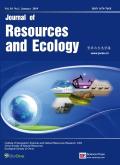Green Water Resource Utilization Efficiency in Urban Agglomerations: Measurement, Spatiotemporal Variations and Influencing Factors
Q3 Environmental Science
引用次数: 0
Abstract
Green development is the coordinated development of the economy, society and environment and has become a mainstream development model. This paper evaluates the green water resource utilization efficiency (GWRUE) of 38 regions in the four-city area in central China during 2010–2019 using a super-slacks-based measure (super-SBM) DEA model considering unexpected output. Then, the spatiotemporal variations in GWRUE are analyzed by the standard deviational ellipse method, and the geographical detector method is employed to reveal the dominant impacts and interaction impacts on GWRUE spatiotemporal variations. The results show that: (1) From 2010 to 2019, the GWRUE in the four-city area in central China was low, and the difference among regions was obvious, showing a downward trend. (2) From 2010 to 2019, the spatial gravity center of GWRUE experienced a change process from northeast to southwest, and its moving speed showed a “waveform” rising trend. Moreover, the standard deviational ellipse (SDE) range of each characteristic time point showed a decreasing trend, indicating that the spatial variations in GWRUE tended to be agglomerated. (3) From 2010 to 2019, the influence of each factor on the spatial variations in GWRUE was different each year. In addition, the two-way interactions between different influencing factors were mainly manifested as bivariate enhancement relationships and nonlinear enhancement relationships and were especially affected by multiple factors that produce a nonlinear enhancement interaction. This study can provide a practical basis for realizing water ecological civilization construction and high-quality development in the four-city area in central China.城市群绿色水资源利用效率:测度、时空变化及影响因素
绿色发展是经济、社会和环境的协调发展,已成为主流的发展模式。采用考虑非预期产出的超流量测度(super-SBM) DEA模型,对2010-2019年华中四城区38个区域的绿色水资源利用效率进行了评价。在此基础上,采用标准差椭圆法分析了GWRUE时空变化,并采用地理探测器法揭示了对GWRUE时空变化的主导影响和交互影响。结果表明:(1)2010 - 2019年,中部四城地区GWRUE较低,区域间差异明显,呈下降趋势;(2) 2010 - 2019年,GWRUE空间重心经历了由东北向西南的变化过程,其移动速度呈“波形”上升趋势。各特征时间点的标准差椭圆(SDE)范围呈减小趋势,表明GWRUE的空间变化趋向于聚集。(3) 2010 - 2019年,各因子对GWRUE空间变化的影响各不相同。此外,不同影响因素之间的双向交互作用主要表现为二元增强关系和非线性增强关系,尤其受多因素的影响,产生非线性增强交互作用。本研究可为中部四城地区实现水生态文明建设和高质量发展提供实践依据。
本文章由计算机程序翻译,如有差异,请以英文原文为准。
求助全文
约1分钟内获得全文
求助全文
来源期刊

Journal of Resources and Ecology
Environmental Science-Ecology
CiteScore
2.40
自引率
0.00%
发文量
107
 求助内容:
求助内容: 应助结果提醒方式:
应助结果提醒方式:


